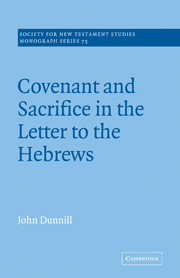Book contents
- Frontmatter
- Contents
- Preface
- List of abbreviations
- A NOTE ON TRANSLATIONS
- Introduction: Hebrews and historical criticism
- Part I Sociology
- Part II Structuralism
- Part III Renewing the covenant
- 4 A liturgy for the Day of Salvation
- 5 The narratives of the covenant
- 6 The testing of the Son of God
- 7 The necessity of blood
- 8 Worship in the new covenant
- Conclusion
- Bibliography
- Index of passages quoted
- Index of modern authors
- Subject index
4 - A liturgy for the Day of Salvation
Published online by Cambridge University Press: 07 January 2010
- Frontmatter
- Contents
- Preface
- List of abbreviations
- A NOTE ON TRANSLATIONS
- Introduction: Hebrews and historical criticism
- Part I Sociology
- Part II Structuralism
- Part III Renewing the covenant
- 4 A liturgy for the Day of Salvation
- 5 The narratives of the covenant
- 6 The testing of the Son of God
- 7 The necessity of blood
- 8 Worship in the new covenant
- Conclusion
- Bibliography
- Index of passages quoted
- Index of modern authors
- Subject index
Summary
Religious language and the genre of Hebrews
In the previous chapter it was argued that the Pentateuch contains materials springing from what has been called the ‘liminal-sacral’ mentality, and that the coherence of these phenomena owes at least as much to an attempted rational systematisation, undertaken by the Deuteronomic and Priestly editors in particular historical circumstances, as to some hypothetical ‘deep-structural’ coherence. Doubt was cast by this on the sufficiency of any pure ‘structuralism’ to replace the historical element in Old Testament exegesis; however, it was noted that, in certain sorts of material, where the rational system of the Priestly code worked against the tendencies inherent in the liminal-sacral (on the question of the ritual meaning of ‘blood’, for example), intertestamental developments show the gradual establishing of a pattern in accord with that logic and its ‘deep structures’. The employment of structuralist techniques was therefore justified by its ability to explain particular non-rational elements in the Old Testament and in subsequent developments.
The question before us now is a ‘structural transformation’ of the previous question: in common with the other books of the New Testament, the Letter to the Hebrews exhibits signs of a liminal-sacral world-view, most obviously in relation to elements of Israel's cultus – the new covenant being presented in imagery drawn from the old.
- Type
- Chapter
- Information
- Covenant and Sacrifice in the Letter to the Hebrews , pp. 115 - 148Publisher: Cambridge University PressPrint publication year: 1993

